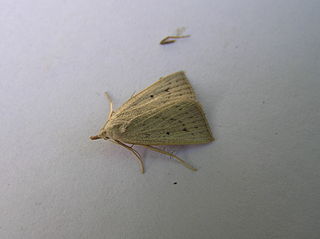
The noctuid (owlet) moth genus Cydosia is the only member of the tribe Cydosiini in the subfamily Acontiinae. The genus was erected by James Duncan with John O. Westwood in 1841. The few species occur from Argentina along the Andes to the Caribbean and Central America, reaching into the southern United States. The unusual format for the authority citation is explained at Butterflies and Moths of the World as "The difficulty can best be overcome by attributing Westwood with anonymous junior authorship."

Chytolita is a monotypic litter moth genus of the family Erebidae erected by Augustus Radcliffe Grote in 1873. Its only species, Chytolita morbidalis, the morbid owlet moth or morbid owlet, was first described by Achille Guenée in 1854. It is found in large parts of North America, from coast to coast in the north and south to North Carolina, Texas and Florida in the west. The habitat consists of deciduous woods and edges.

Isogona is a genus of moths of the family Erebidae. The genus was erected by Achille Guenée in 1852.
Deinopa is a genus of moths of the family Erebidae erected by Francis Walker in 1856. The genus was previously classified in the subfamily Calpinae of the family Noctuidae.
Glympis is a genus of moths of the family Erebidae. The genus was erected by Francis Walker in 1859.
Lycimna is a monotypic moth genus of the family Erebidae. Its only species, Lycimna polymesata, is found in the north-eastern Himalayas, Borneo, Sumatra and Java. Both the genus and the species were first described by Francis Walker in 1860.

Macrochilo is a genus of litter moths of the family Erebidae. The genus was erected by Jacob Hübner in 1825.

Marimatha is a genus of moths of the family Noctuidae. The genus was erected by Francis Walker in 1866.

Niphonyx is a monotypic moth genus of the family Noctuidae erected by Shigero Sugi in 1982. Its only species, Niphonyx segregata, the hops angleshade, was first described by Arthur Gardiner Butler in 1878. It is endemic to eastern Asia, including the Russian Far East, the Korean Peninsula, Japan, China and Taiwan. It was introduced to the north-eastern United States in the 1990s and is found from Connecticut south to at least Delaware.
Ossonoba is a monotypic moth genus in the family Erebidae. Its only species, Ossonoba torpida, is found in Darjeeling, India. Both the genus and the species were first described by Francis Walker in 1866.

Phalaenophana is a genus of litter moths of the family Erebidae. The species was first described by Augustus Radcliffe Grote in 1873.

Phalaenostola is a genus of litter moths of the family Erebidae. The genus was erected by Augustus Radcliffe Grote in 1873.

Polygrammate is a monotypic moth genus of the family Noctuidae. Its only species, Polygrammate hebraeicum, the Hebrew moth or Hebrew, is found in the eastern parts of North America, from Ontario, south to Florida and as far west as Texas. Both the genus and the species were first described by Jacob Hübner in 1818.
Tibracana is a genus of moths of the family Erebidae. The genus was erected by Francis Walker in 1866.
Trauaxa is a monotypic moth genus of the family Erebidae. Its only species, Trauaxa obliqualis, is found in Mexico, Panama, Honduras and the Brazilian state of Amazonas. Both the genus and the species were first described by Francis Walker in 1866.

Palthis asopialis, the faint-spotted palthis moth, is a moth of the family Erebidae. The species was first described by Achille Guenée in 1854. It is found in North America, from Florida north to Ontario and west to Texas.

Idia rotundalis, the chocolate idia or rotund idia moth, is a litter moth of the family Erebidae. The species was first described by Francis Walker in 1866. It is found from southern Canada to Florida and Texas.
Spargaloma is a monotypic moth genus in the family Erebidae. Its only species is Spargaloma sexpunctata, the six-spotted gray. Both the genus and species were first described by Augustus Radcliffe Grote in 1873. It is found from coast to coast in lower Canada south in the east to Florida, Mississippi and Arkansas, in the west to California.

Albara reversaria is a moth of the family Drepanidae. It was described by Francis Walker in 1866. It is found in Sumatra, Borneo, Peninsular Malaysia, the north-eastern parts of the Himalaya and Taiwan.
Aglossa costiferalis is a species of snout moth in the genus Aglossa. It was described by Francis Walker in 1866. It is found in eastern North America.












